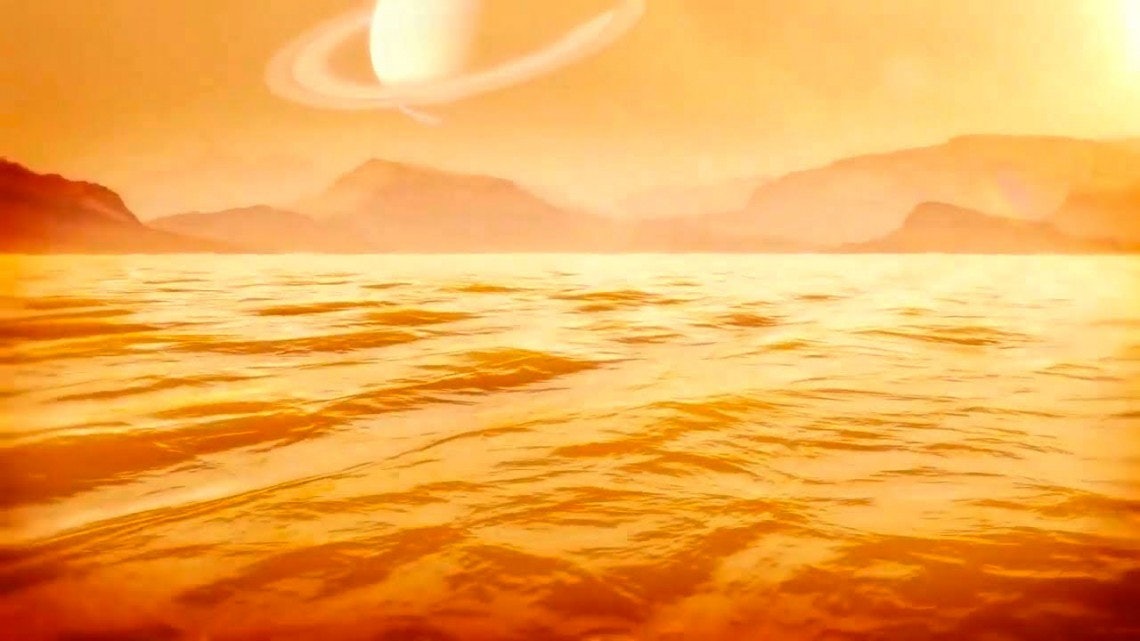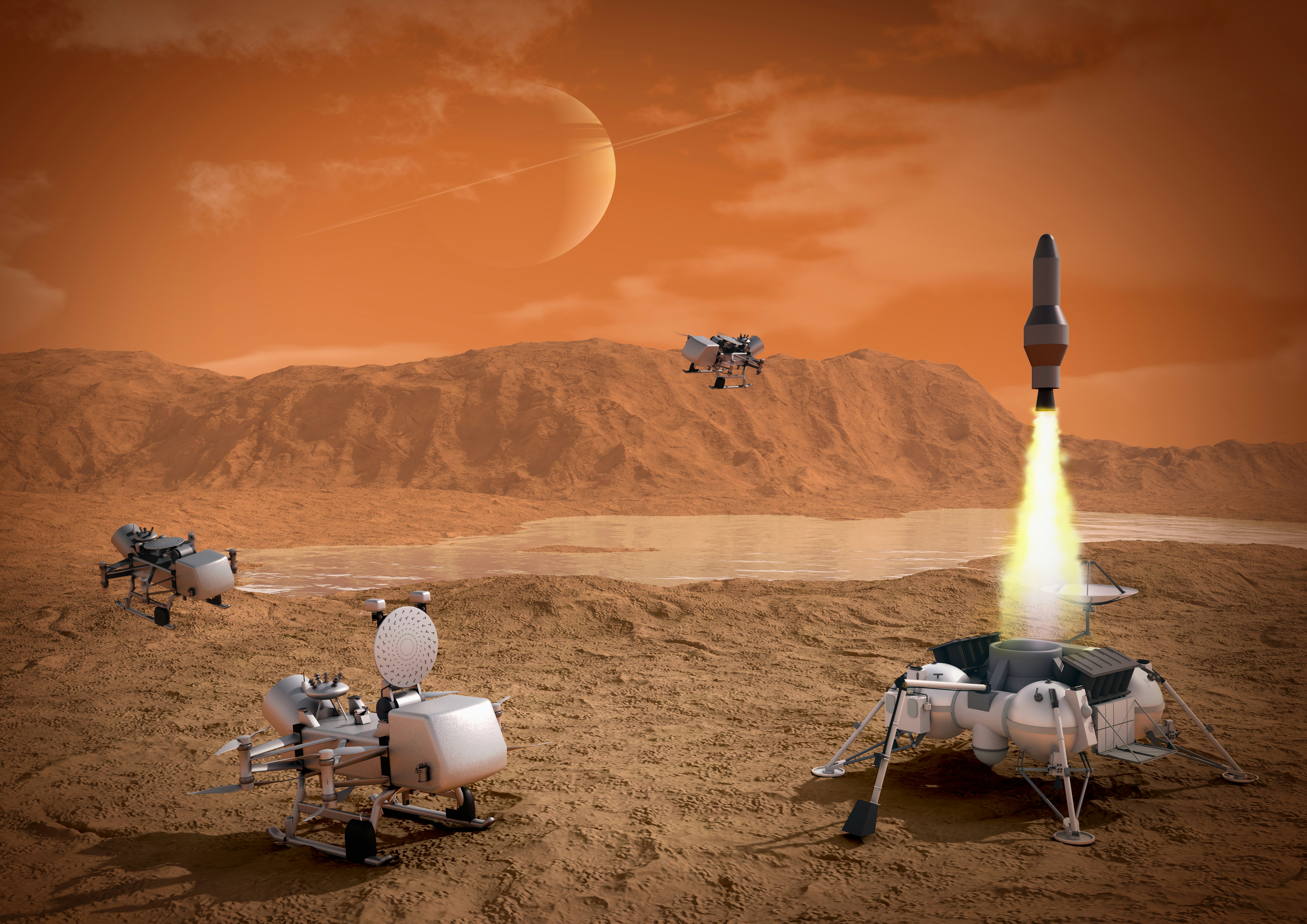
Future explorers of Saturn’s moon Titan may get to surf on waves of rocket fuel. The icy shorelines of Titan’s southern lakes may be sculpted by waves of liquid methane, according to a recent study.
A team of geologists and planetary scientists modeled the geometry of wave-battered shorelines here on Earth, then compared them to the lakes and seas of Saturn’s moon Titan: an alien deep-freeze of a world, where big round drops of liquid methane and ethane rain down into hydrocarbon seas, which wash against shores of water ice frozen as hard as rock. The geologists found that some of the shorelines of Titan’s southern seas, pools of liquid methane the size of the Great Lakes, seem to have been eroded by wave action.
Geologist Rose Valermo of the U.S. Geological Survey and her colleagues published their work in the journal Science Advances.

Surf’s Up on Titan
The team of planetary scientists built computer simulations of how shorelines erode here on Earth. These factors include pounding waves, rising waters, and dissolving limestone. Next, they compared those models to the geometry of actual shorelines around seven lakes: three flooded reservoirs, a couple of karst lakes in water-soluble limestone rock, and two lakes with waves washing against their shores. The models did a good job of predicting what kind of shoreline had been sculpted by which process, so Valermo and her colleagues applied them to several of Titan’s strange methane lakes.
Titan is a delightfully, fascinatingly weird place, even by the standards of people who write about alien planets for a living.
Other than Earth, it’s the only place in the Solar System with liquid on its surface. But Titan’s lakes are made of liquid methane (better known as the rocket fuel that propels SpaceX’s Super Heavy rocket) and ethane, sloshing around at a chilly -300 degrees Fahrenheit. Some of the lakes are more like small ponds, while others rival the Great Lakes here on Earth, and all are fed by rushing rivers of rocket fuel. There’s a methane cycle on Titan just like our water cycle here on Earth: Methane evaporates from the surface, forms clouds in the mostly-nitrogen atmosphere, and then rains down to the ground again to fill lakes, rivers, and seas.
Rain on Titan must look absolutely surreal, because it falls through an atmosphere 50 percent denser than Earth’s, pulled downward by just one seventh the gravity, so it drifts down slowly, in shimmering spheres. The ground is water ice, but it’s frozen so hard that it behaves more like rock than like the ice we’re used to seeing on Earth. And like rock here on Earth, it’s shaped by the liquid that flows across it.
Valermo and her colleagues hope that understanding the shapes of Titan’s shores and bays might hold some clues to the strange world’s geological history, its climate, and its future.

Mapping Alien Shores
We’ve never seen waves on Titan, at least not for sure. NASA’s Cassini spacecraft (RIP) may have captured images of rough patches on the surface of one of Titan’s seas, and the spacecraft’s radar may have spotted the bright reflections of waves in another sea, Ligeia Mare. Unfortunately, though, the images aren’t quite detailed enough for scientists to be sure what they’re seeing. But it makes sense for Titan’s rocket fuel seas to have waves, with an atmosphere 50 percent denser than Earth’s, and seas hundreds of miles wide.
Valermo and her colleagues noticed that several of the seas in Titan’s southern hemisphere, including one called Ontario Lacus, have long stretches of smooth shoreline; the coast only looks rough and jagged where it’s tucked into a bay, sheltered from the waves rolling in from the open sea. But it’s hard to say for sure, just by looking, what factors have shaped a coastline, even here on Earth.
So Valermo and her colleagues turned images of Titan’s seashores into math describing the geometry of the coastline and the possible distance wind could blow waves across the sea’s surface at each point. When they tested their model on seven lakes here on Earth — ones whose geological histories are well known — it turned out to be pretty good at predicting whether a lake’s shoreline had been worn smooth by waves, eaten away by dissolution, or just flooded.
On Titan, the model suggested that several of Titan’s methane seas, including Ontario Lacus in the south, as well as Kraken Mare and Ligeia Mare in the north, have long stretches of what’s probably wave-washed shoreline.
“Our results do not prove that waves form on Titan. This would require direct observations,” write Valermo and her colleagues in their recent paper. But those results do strongly suggest that some of Titan’s lakeshores look more like they’ve been gradually worn down by waves than anything else.
Several of the seas and lakes around Titan’s north pole, though, looked quite different. These lakes have rougher coastline with no sign of erosion; the model suggested that the best explanation for the shape of these lakes was that rivers had carved valleys in the landscape, and rising sea levels had flooded those valleys fairly recently, without time for much erosion to happen. The result probably looks similar to the Scandinavian fjords — or flooded, human-made reservoirs like Lake Lanier — here on Earth.
We won’t know for sure what Titan’s seas and beaches are like until NASA’s Dragonfly mission arrives in about a decade. When it does, the coastlines are likely to be points of interest.
“The various landforms produced by coastal erosion would be high-priority targets for future Titan orbiter and lander missions,” write Valermo and her colleagues.







